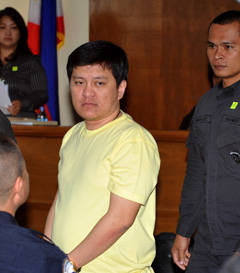A judge’s decision today to set a September 1 trial date for several defendants in the Maguindanao massacre highlights a positive development in what has been a very ugly story. The judge appeared determined to move the case forward and, for now, seemed able to keep the large legal teams in line.
Quezon City Regional Trial Court Justice Jocelyn Solis-Reyes needed only 45 minutes to set a no-nonsense tone for a case that is going to be closely watched in the Philippines and around the world. Recently elected President Benigno Aquino and his justice secretary, Leila de Lima, have made it clear that they grasp the importance of building a dynamic legal system to match their aspirations for national growth. De Lima has been calling the Maguindanao trial a “litmus test” for a Philippines judicial system that has been known for extended delays and pervasive conflict of interest.
In 66 journalist murders since 1992, prosecutors have won only five convictions, CPJ research shows. And most of those convicted were the hit men–guns for hire who didn’t know their victims beyond recognizing their faces, skilled at carrying off drive-by killings, often while mounted on motorcycles. None of the plotters–the powerful people with the money to pay someone to do their dirty work–has been brought to justice. The most glaring example is the March 2005 murder of Marlene Garcia-Esperat, in which two prominent public officials accused of masterminding the crime have remained free. Only the gunmen have been tried and convicted in the Garcia-Esperat killing, which also occurred in Mindanao.
CPJ’s Impunity Index, an annual assessment that calculates unsolved journalist murders as a percentage of each country’s population, ranks the Philippines as the third worst country in the world in bringing the killers of journalists to justice. Only Iraq and Somalia, two war-riven nations, are worse. The problem in the Philippines is not unique to journalist killings; the country’s judicial system has an abysmal overall conviction rate in murder cases. Detlev Mehlis, who heads the European Union’s Philippine Justice Support Program, puts the Philippines murder conviction rate at 10 percent.
The prosecution in the Maguindanao killings could provide a turning point for this faltering system. Thirty-two media journalists and workers were slain in the Maguindanao massacre, which took 57 lives in all. The politically motivated killings were the deadliest event for the press ever recorded by CPJ.
Relatives of the victims occupied much of the Quezon City courtroom at today’s hearing. The families had been brought on commercial flights from their homes in Mindanao with support from the national press freedom community and international backing. The families have been divided into three groups of about 20 each. They will rotate through the trial sessions, each group flying up and back from Mindanao to Manila. Continued support, both national and international, will be needed to help the families, most of whom lost their primary bread-winners in the massacre.
“I’m not sure if what we’re doing will make a difference, but what can we do?” one family member told me. “We’re working to bring these men to justice. Even if we don’t, it will have been better to have tried than to have just sat silently.” It was a bleak statement, struggling to be positive against a backdrop of women dressed in black, handkerchiefs to their faces. Some men wore t-shirts, their backs carrying the lines “Heirs of 11/23 Heroes Incorporated.”
As the courtroom cleared out, a reporter from the Philippine Daily Inquirer asked me for some thoughts. His first question: “People are saying this trial could take a decade. Do you think that’s true?”
That’s for the government and the judge to determine, I answered, although the record makes it seem all too possible. Today’s hearing and the setting of a trial date from a no-nonsense judge seemed to be a break from the past. But we’re still at the start of a long process.
(Reporting from Manila)
